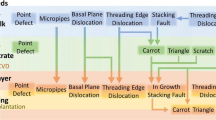Abstract
A plasma immersion ion implantation (Pill) hydrogenation process using an inductively-coupled plasma (ICP) source is implemented for defect passivation in polycrystalline silicon (poly-Si) thin film transistors (TFT’s). Device parameter improvement saturates in 4 minutes, which is considerably shorter than for other reported hydrogenation methods. Stress test indicates that the devices hydrogenated by this novel technique have much better long-term reliability. The hydrogenation effects on two types of trap states are analyzed the current-voltage characteristics of the devices. The densities of deep states and tail states are significantly reduced after short time hydrogenation.
Similar content being viewed by others
References
T. I. Kamins and P. J. Marcoux, “Hydrogenation of transistors fabricated in polycrystallinesilicon films, ” IEEE Electron Device Left., vol. 1, no. 8, pp. 159–161, 1980.
I. Wu, T. Huang, W. B. Jackson, A. G. Lewis and A. Chiang, “Passivation kinetics of two types of defects in polysilicon TFT by plasma hydrogenation, ” IEEE Electron Device Lett., vol. 12, no. 4, pp. 181–183, 1991.
R. A. Ditzio, G. Liu, S. J. Fonash, B. C. Hseih and D. W. Greve, “Short time electron cyclotron resonance hydrogenation of polycrystalline silicon thin film transistor structures, ” Appl. Phys. Lett., vol. 56, no. 123, pp. 1140–1142, 1990.
K. Baert, H. Murai, K. Kobayashi, H. Namizaki and M. Nunoshita, “Hydrogen passivation of polysilicon thin-film transistors by electron cyclotron resonance plasma, ” Jpn. J Appl. Phys., vol. 32, pp. 2601–2606, 1993.
J. D. Bernstein, S. Qin, C. Chan, and T.-J. King, “Hydrogenation of Polycrystalline Silicon Thin Film Transistors by Plasma Ion Implantation, ” IEEE Electron Device Lett., vol. 16, no. 10, pp. 421–423, 1995.
S. Qin, J. D. Bernstein, Y. Zhou, W. Liu, C. Chan and T.-J. King, “Short-time Hydrogen Passivation of Poly-Si CMOS Thin Film Transistors by High Dose Rate Plasma Ion Implantation, ” Mater. Res. Soc. Symp. Proc., vol. 396, pp. 515–520, 1996
M. Cao, T.-J. King, and K. C. Saraswat, “Dtermination of the Densities of Gap States in Hydrogenated Polycrystalline Si and Si0.8 Ge0.2 Films’, Appl. Phys. Left., vol. 61, no. 6, pp. 672–674, 1992.
K. Ono, T. Aoyama, N. Konishi, and K. Miyata, “Analysis of Current-Voltage Characteristics of Low- Temperature-Processed Polysilicon Thin Film Transistors”, IEEE Trans. on Electron Devices, vol. 39, no. 4, pp. 792–802, 1992.
J. Levinson, F. R. Shepherd, P. J. Scanlon, W. D. Westwood, G. Este, and M. Rider, Conductivity Behavior in Polycrystalline Semiconductor Thin Film Transistors, ” J Appl. Phys., vol. 53, no. 2, pp. 11931202, 1981.
J. F. Ziegler, J. P. Biersack, and U. Littmark, The Stopping Range of Ions in Solids, Pergamon Press, New York, 1985.
E. H. Nicollian and M. Aucouturier, “Electron Spin Resonance of Hydrogenation Effects in Polycrystalline Silicon, ” Appl. Phys. Lett., vol. 49, pp. 1620, 1986.
Author information
Authors and Affiliations
Rights and permissions
About this article
Cite this article
Zhou, Y., Qin, S. & Chan, C. Investigations of Plasma Immersion Ion Implantation Hydrogenation for Poly-Si TFTS Using an Inductively Coupled Plasma Source. MRS Online Proceedings Library 439, 269–274 (1996). https://doi.org/10.1557/PROC-439-269
Published:
Issue Date:
DOI: https://doi.org/10.1557/PROC-439-269




